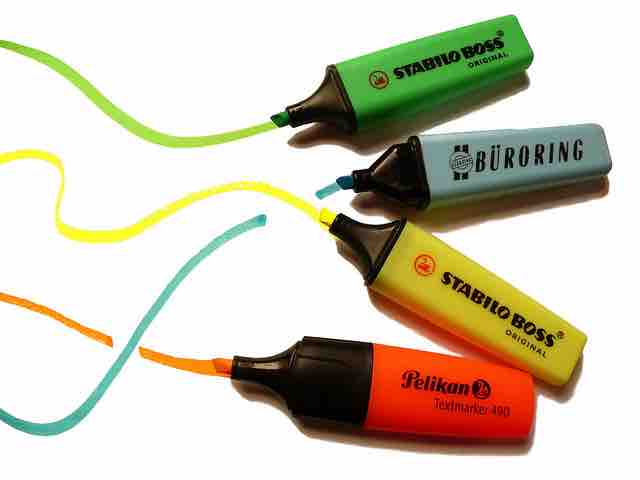Highlighting Main Points
The scenario: your teacher is droning on and on, and your mind wanders..."Mmm, food. What's in the fridge? Should I buy groceries after class? What could I make for dinner? " When you snap back into focus, the teacher has just finished explaining a key concept. Nothing else makes sense without that piece of the puzzle, but you can't just turn back a page or hit rewind, so you're out of luck! We've all been there, right? This is an important lesson for public speakers: no matter what you do, audience members will zone out occasionally. In an ideal world, your listeners would cherish every word that comes out of your mouth, but in the real world, that's not going to happen. It's practically a law of nature, so you might as well accept it and plan accordingly: highlight your main points to help your audience catch the most important ideas.
Visual and Textual Cues
Public speakers can highlight important points using visual cues and textual cues. Visual cues are cues the audience can see, including aids such as slides, handouts, and charts, and also the speaker's body language. Textual cues relate to the content of the speech: signal words and phrases, examples, anecdotes, and selections of text that appear on a slide or handout. Take responsibility for your message and use some of these tried and tested techniques to get your message across.

Highlighters
Public speakers can use visual aids and textual cues to highlight their main points.
Highlighting with Visual and Textual Cues
Some studies estimate that 65% of Americans are primarily visual learners, while 30% work best with auditory learning and 5% thrive with kinesthetic (or hands-on, touch-based) learning. This puts public speakers at a disadvantage, since only 30% of Americans learn best by listening. Fortunately, speakers can use visual cues to make their words "stick. " For examples of visual cues, just look at the page you are reading right now. Important points are highlighted with topic headings in large typeface, bold font, italics, bulleted lists, banks of key terms, etcetera: the visual presentation of a printed page functions as a guide for the reader. For a speech, the rules are a little bit different. To highlight key terms and new topic headings, a speaker can create slides or handouts that outline the speech's main points. To convey the effect of italics or bold print, a speaker has to rely on tone of voice rather than visual cues. To combine visual and kinesthetic learning, speakers can poll the audience and ask them to raise their hands and look around the room to see the results. Here are several techniques for using visual aids such as slides, handouts, or posters to enhance your presentation:
Highlighting with Graphics
Graphics such as charts and pictures can make a presentation more engaging by illustrating the main points. If you support your claims with numbers, visual aids such as charts, graphs, and models would help your audience understand the figures easier and faster. If your speech describes people, places, or objects, pictures of those subjects would make your presentation more vivid and interesting.
Highlighting with Text
Visual aids such as slides, handouts, and posters are excellent ways to highlight key phrases, definitions, quotes, and lists. Spoken words can evaporate as soon as they leave your mouth, but written words stay in place--they're not going anywhere. Try to put your most important points in concrete form. For example, a slide show that lists important definitions allows the audience to copy the definitions exactly as they appear, refer back to them, and make mental notes of the most important terms. When you make an outline of your speech, keep the question of visual aids in mind. You can save time with an outline that converts easily into visual aids: remember this when you choose subject headings, definitions, quotes, and key phrases.
Highlighting with Signal Words and Phrases
Signal words and phrases are designed to command attention. These verbal road signs have many uses, one of which is to highlight important points. Here are some examples of signal words and phrases that will alert your audience to pay attention: important, noteworthy, crucial, vital, major, principal, primary, central, valuable, defining, distinctive, relevant, above all, in the end
Highlighting with Examples
Precept is instruction written in the sand. The tide flows over it, and the record is lost. Example is graven on the rock, and the lesson is not soon lost.
-William Ellery Channing
Instructions, rules, and descriptions are all great, but if you want to make a concept stick, support it with an example. Different types of examples include facts, figures, data, illustrations, anecdotes, and quotes. As an illustration, compare the following two versions of the same point:
- Many Americans struggle with debt. For this reason, affordable health care is an important priority for our country.
- Anne Smith is one of the forty-six million Americans who live below the poverty line today. Last week, Anne arrived at the emergency room of Lutheran General Hospital unconscious and seriously injured after a drunk driver hit her and left her half dead. Anne survived, thanks to the hard-working EMTs at Lutheran General, but she woke up the next morning with $120,000 in medical bills. A health care system that cripples its patients with debt is not consistent with a healthy economy: Americans like Anne deserve better.
The second version combines facts, figures, and an anecdote to convey the human impact of the situation along with its broader significance. That is the power of example in action.